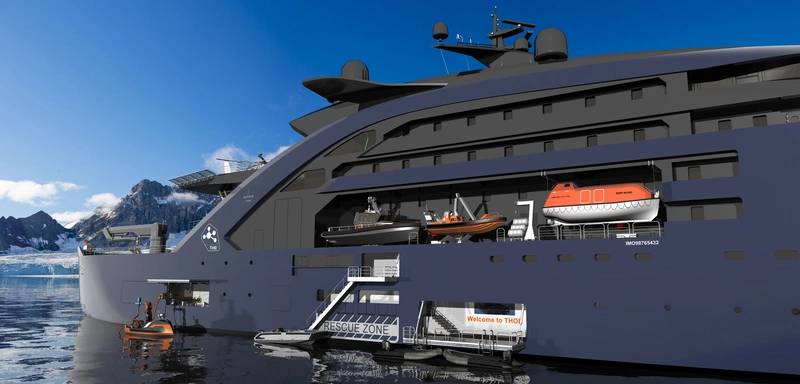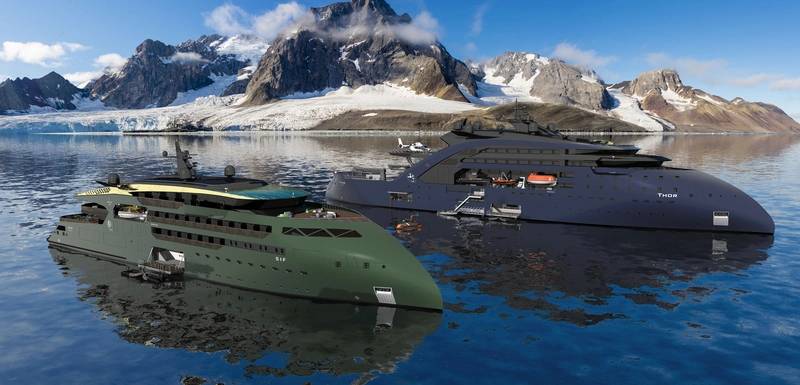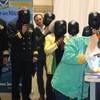Molten Salt Reactors: Maritime’s Nuclear Option
A race is being run by nuclear scientists and ship designers. The prize? “Decarbonization’s” holy grail — believed to be a “small” thorium-fueled, molten-salt rector’s unlimited power to propel sea trade. At the same time, a recently revived discussion among leading marine-nuclear thinkers revolves now around how to put an ultra-modern, as-yet non-existent marine reactor aboard a modern commercial vessel. As with nuclear power generally, shipborne reactors produce national discussion first, then discovery. Now its global, and vessel designs are on the table.
The word is, “Don’t be afraid” of upcoming marine nuclear. Leading reactor technology based on heating thorium then dissolving it as a fluoride in salt would, in a core explosion, only contaminate what the debris would touch. “An easy clean-up,” one marine-nuclear developer says. No cause for alarm.
Among the keenest green-marine advocates, there’s an admission that rare earth elements will not be enough to decarbonize shipping. Some see the answer in portable nuclear reactors fueled by readily available thorium — found on Brazilian and Indian beaches or mined with rare-earths. Meanwhile, the land-based nuclear supply chain is ready to lend a hand, and thorium research reactors small modular reactors seem to be growing in number (in all, some 70 compact designs worldwide, according to the IAEA). Specifically, the molten-salt reactor (MSR) is among a range dubbed Generation IV reactors and praised for their “walk-away safety, proliferation resistance and very long refueling cycles,” says Phil Lewis, Director of Research, Intelatus, a market analysis organization in the energy, marine and industrial sectors.
China “crisis”
Until this week, another group of reactor types — the pressurized-water reactors aboard icebreakers, a pair of cargo vessels and power barges — were what China and Russia had built and operated as floating power. The designs were “not Gen IV and require a return to shipyard every few years for refueling — a long task,” Lewis adds.
Yet, as we went to press, China had just fired-up its first molten-salt fission reactor, part of a plant to electrify the Gobi Desert. The benefits of MSR’s running on thorium made headlines. The reactors don’t need to be water-cooled. Thorium’s half life of radioactivity is 100 years not several thousand like uranium. The MSR heat produces no steam on its own, so no explosive pressure, unless you want to produce steam to power a steam. There’s less nuclear waste.
With uranium rods as fuel, a ship-owner is looking at “up to seven months” of downtime (according to a process industry report) when returning to port to refuel.
Ulstein and the Norwegians
Some 60 years have passed since the nuclear-powered USS Triton submarine made headlines for circumnavigating the globe. Yet, in the past six months — six weeks — the amount of nuclear news and marine nuclear news has been head-spinning.
Ever since fabled Norwegian shipping concern, Ulstein International, in April 2022 unleashed renderings of a nuclear-electric charging vessel, the Thor, and adventure cruise vessel, Skif, nuclear news has flashed in of other designs that could lead to marine nuclear. Newsweek reported in August that scientists at the National Ignition Facility had achieved nuclear ignition in a fusion reactor just as scientists were getting ready to unveil the commissioning of a thorium MSR reactor at SINAP’s test lab in Huawei (Ulstein has a Chinese yard, so who knows). Bill Gates’s brainchild, TerraPower, also reported millions of dollars of funding for its natrium molten salt program. In all these cases — thorium fission, fusion ignition and then natrium — the launch of anything other than a concept was said to be 15 years away. Materials development — especially as the thorium process corrodes — is priority No. 1.
“We believe it will be less than that,” says Ulstein spokesperson, Tonje Ruud, before handing off to the X-bow visionary, chief designer Kamsvaag. In its Marine Report to 2050, Class standard-bearer DNV also expressed belief in marine nuclear and already issues a three-year ISO certification of nuclear management (ISO 19443), while nuclear physics professors at Norwegian NTNU are determined to push the radioactive element discovered 200 years ago by Norwegian vicar, Morten Esmark.
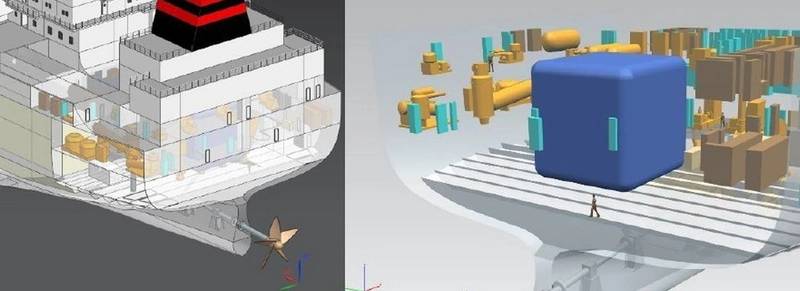 An artist’s impression of a modular reactor as it would appear aboard a large LNG carrier. Photo credit NTNU/Nuproship
An artist’s impression of a modular reactor as it would appear aboard a large LNG carrier. Photo credit NTNU/Nuproship
- ABS, DOE to Examing Nuclear Energy for Maritime
The U.S. Department of Energy (DOE) has awarded ABS a contract to research barriers to the adoption of advanced nuclear propulsion on commercial vessels. The $800,000 research project – awarded by the DOE’s Office of Nuclear Energy last year and formally contracted through its U.S. Industry Opportunities for Advanced Nuclear Technology Development funding opportunity – will address challenges to adopting new reactor technology in commercial maritime applications. ABS will develop models of different advanced reactor technologies for maritime applications and develop an industry advisory on the commercial use of modern nuclear power.
Support will be provided by the Department of Energy’s National Reactor Innovation Center (NRIC), based at Idaho National Laboratory. NRIC will provide the advanced reactor framework to help propose how a maritime nuclear demonstration could take place.
In a separate, smaller award, the DOE has also contracted ABS to support research into molten salt reactors being carried out by the University of Texas.
Thor the Enabler
Kamsvaag admits that in the aftermath of launching Thor — envisioned as an at-sea floating nuclear power platform, green fuels refiner, rescue and research ship — interest in seagoing marine-nuclear has been palpable. “Various applications — we can say that we have been approached by several types of ship owners interested in both the thorium-powered vessel and, among existing clients, the Skif (all-electric adventure-cruise).”
So, when can you buy a nuclear-powered vessel that won’t need a nuclear physicist onboard? Kamsvaag offers a clue to just how new all this is by referring to the reactor element in the Ulstein design as “a heat battery”. That, for many, is how thorium-power will play out: a free-ranging vessel, the Thor, converts the heat of its reactor into steam or steady current (or ammonia) akin to the steady fuel of ship-to-ship transfers from a bunkering vessel (next issue). Some of the interest in Thor, he says, was in the thorium idea and in the different types of nuclear and produced fuel, including what best cools nuclear fuel to render thorium safe.
“Thor is an enabler,” he says. “You have to create the infrastructure charging stations (at sea).”
Reactors and vessels
Most reactors are considered “Gen-II thermal, slow-neutron fission reactors” and have been in service for decades. These are pressurized water reactors (PWR), boiling water or “water-water energy”. Gen. III’s, Lewis says, are safer and simpler to build. Gen. IV’s — run at high temperature and using sodium, lead, gas, supercritical water or molten salt coolants — “promote safety, reliability, sustainability, economics and proliferation resistance”, says Lewis, adding that safer cores make Gen IV’s favorable for widespread use. The Thor is envisioned running a Gen IV.
A Gen IV suitable for a range of ships is the goal of NTNU researchers now tasked with finding the right concepts under the Nuproship merchant ship project. A contender might be the liquid-lead-cooled Swedish SMR concept from marine-nuclear player, LeadCold, and its SEALER design. An arctic version runs not on thorium but on 2.4 tons of 19.9 percent enriched uranium oxide generating up to 55 MW on a core that’ll live up to 30 years. It’s priced at just under USD 100 million, but like some emerging UK SMR designs, can be factory-built. NTNU will also evaluate CorePower’s reactor design for a cargo ship concept.
“There are several categories of SMRs to consider,” Lewis says. Traditional water-cooled, land-based reactors are mainly PWRs, and their marine equivalent are found in Russia’s icebreaker, cargo ship and floating-power designs.
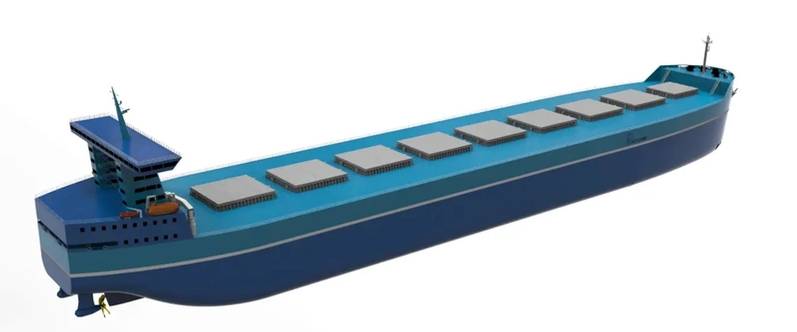 A new application: Corepower’s nuclear cargo concept. Image courtesy CorePower
A new application: Corepower’s nuclear cargo concept. Image courtesy CorePower
SMR ascendingEnter the SMR reactor. “This is where there is excitement for marine applications,” Lewis explains, rather pointedly: “(SMRs) are high-temperature fast spectrum Gen IV reactors. Two main types of coolant salts — fluoride and chloride. (They) can feature 20 to 40-year refuelling cycles.” So, no return to port for two to four decades.
They’re also being called small module (or multi-modular) reactors (SMRs). “As an energy source, SMRs provide the flexibility to support applications requiring electricity and heat,” Lewis says, adding, “A key feature of the latest generation of SMRs is passive safety to mitigate the likelihood and scale of an accident.” We ask whether consuming spent fuel from existing reactors — sometimes called MOX — might be a worthwhile feature. Canadian reactors (CANDUs) once advertised this flexible feedstock ability. Lewis says, “A feature of advanced, fast neutron SMRs is that they incorporate alternative coolants and advanced fuels.”
Price “speculative”
Fast neutron SMRs suitable for marine propulsion are under development in Europe, Japan, North America, Russia — and Africa. In mid-August, President Biden promised cash for nuclear research, just after the European Commission declared nuclear power “green”. Matching funds are available for SMR “pilots” that do the demo and produce the docs to speed us toward licensing. Class standard bearers, too, have shown a keenness to help frontrunner designs and qualify the supply chain for “multi-module manufacture”.
“We’re open to all supplies of tech. It could be a Norwegian solution,” says Kamsvaag, with Ruud adding, “We are too few people. It has to be a global initiative.”
The world is knowledgeable about the costs. Just two of 17 thorium-powered reactors built in the world are still in service (both in India). A prototype, utility-sized reactor is estimated to cost “well under USD 1 billion” by US experts, or “USD 444 million” by those in the know about SINAP’s thorium test build. “Thor is a very large investment,” says Ruud. “The customer is probably not the shipowner.”
Leonid Andeev, writing about the economy of thorium for Norway’s Bellona Foundation in 2013, said that much was “speculative” about thorium’s economic gains. “So far, one can offer but “guesstimates” as to the likely cost of thorium-produced energy as compared to that of energy derived from uranium.” He referred to a UK National Nuclear Laboratory report from 2010: “the thorium fuel cycle” did not, in 2010, “have a role to play in the UK context, other than its potential application for plutonium management ... The technology is innovative, although …immature and … not of interest to the utilities, representing significant financial investment and risk without notable benefits. In many cases, the benefits of the thorium fuel cycle have been overstated.”
Marine-nuclear & CorePower
What a difference a decade makes! Wikipedia will tell you of US interest and assistance in the Chinese MSR success. U.S. influence has also stirred renewed U.K. and Danish interest not just in thorium but in its marine applications.
Lewis, insistent on the benefits, says, “Based on TerraPower’s MSR design, the U.K.’s CorePower is developing an MSR fueled by chloride salts that is aimed specifically at marine applications. Designed for ship propulsion, CorePower plan to initially deploy its MSRs on floating production units that produce hydrogen-based shipping fuels, such as ammonia.” A first concept appears to be a container vessel.
Meanwhile, South Korea’s Ulsan National University of Science and Technology is leading a consortium of industry and university partners to develop a Gen-IV 20 MW fast-spectrum SMR with a 40-year fuel life for marine propulsion. Singapore, too, has a ship-shaped reactor test bed called Earth 300.
The alternative is a Russian, Rosatom reactor, but it would need to refuel, at best, every five years, says Lewis. To refuel, the unit needs to return to Russia for refueling, understood to take many weeks. “MSR designs feature a number of fuel types — low enriched uranium, thorium, plutonium, TRISO, and molten chloride/fluoride salt. Each of these has different refueling cycles.”
Renewed enterprise
The original proponents of burning thorium dissolved as a fluoride in molten salt were Americans, Ralph Moir and Edward Teller back in 2005.
Yet, it was the designer of the SSN Nautilus’s reactor, Alvin Weinberg (Chuck Hawkins: 100 percent Renewables a Delusion) who envisaged a thorium reactor “taking over commercial power, ship propulsion, and water desalination” — back in 1955! Thor is now doing some of that. Yet, the Ulstein concept carries passengers, and Kamsvaag concedes the need to address people’s concerns about stepping onto a nuclear-powered vessel, perhaps in the arctic. “It’s important for us to educate the public. We have to talk to politicians. Flag states …”
Yet, the reaction to Thor was not what was expected. “We did not expect public opinion to be … (so super-positive). Nuclear power has a certain color to it,” he says. “There is a bit of resistance, but all see that in the next 2000 years you’ll still need energy.”
Workshops and talks on getting that type of energy onto Ulstein designs — “the practical part” — start this fall. Maritime Reporter suggests taking in a CorePower seminar on marine-nuclear.
Asked if captains of vessels like the Thor will need a physicist or nuclear engineer onboard, he shrugs. “He’ll probably have to have a science officer.”
Logical, we think.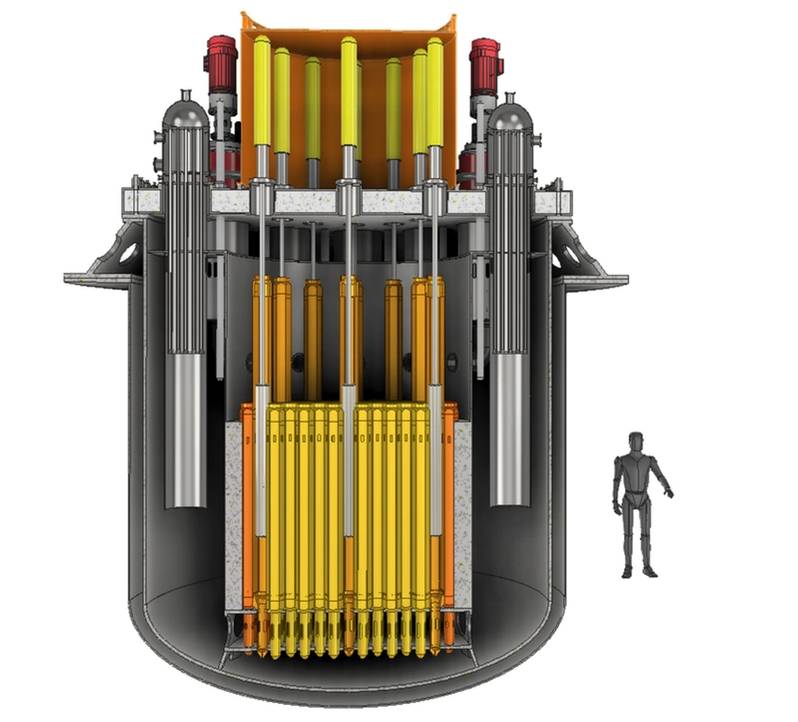 Liquid lead: the Swedish Advanced Lead Reactor, or SEALER, is “passively safe” for being lead-cooled, compact, and aluminum-alloyed. Image courtesy LeadCold
Liquid lead: the Swedish Advanced Lead Reactor, or SEALER, is “passively safe” for being lead-cooled, compact, and aluminum-alloyed. Image courtesy LeadCold
Post Script: Following this article's publication in the September 2022 edition of Maritime Reporter & Engineering News, Philip Lewis, Director of Research, Intelatus, wrote the following "Letter to the Editor" for clarification and amplification of the topic.
Maritime’s Nuclear Option: There’s so Much More
Dear sir,
I would like to make to some enhancements to the detailed article entitled Molten Salt Reactors, Maritime’s Nuclear Option featured in the September edition of Maritime Reporter & Engineering News.
The article features the Ulstein concept for a thorium molten salt reactor in what is essentially a mobile charging station for other zero emissions vessels - it is a hybrid floating nuclear power plant and ship. I would like to give some additional context to the information presented in the article.
Marinized nuclear reactors have been deployed in both naval and commercial segments for some time. But their wide scale commercial deployment rests on being able to address to following:
- Nuclear reactors are flexible and produce electricity and heat. These outputs can be used to drive a vessel, produce utility power, heat and water or to produce clean hydrogen-based fuels in large quantities. Note, the high temperatures associated with some new generation reactors are particularly well suited to hydrogen production.
- Marinized nuclear reactors can be deployed on deep see container vessels, tankers and bulk carriers, floating nuclear charging stations for zero emissions vessels (as per the Thor concept), floating power, heat and water plants (FNPPs) and floating low and zero carbon fuel production, storage and offloading units (FNPSOs). It is likely that the initial advances in adopting commercial marinized nuclear reactors will be in the field of FNPPs and FNPSOs.
- Addressing genuine fears on nuclear safety and proliferation, as enshrined in the Generation IV Forum design principles for advanced small, modularized nuclear reactors.
- Most land-based reactors are first-of-a-kind projects, featuring high capital costs and customization, leading to long construction schedules. Gen-IV small, modularized reactors are designed to be mass produced in factories and transported by road or rail. Mass production through minimal customization creates economies of scale that lower unit prices over time. Building marinized nuclear reactor projects requires a paradigm ship in financial thinking. Marinized nuclear reactor project costs are front loaded in terms of high capital expenditure. However, low operating costs based on low fuel costs in the operating phase result in competitive whole life costing.
- Maritime conventions were not generally written with nuclear power vessels in mind and require modifications and do the shipping laws of individual countries where nuclear powered vessels will call or operate. Steps are in place in some markets, but significant work still needs to be done.
- A nuclear engine room is somewhat different from a conventional engine room, although the remaining electrical propulsion systems will be familiar to an increasing number of engineering teams. Training and development of engineers is required.
Nuclear reactors have powered naval ships since the US Navy lunched the submarine Nautilus in 1955. According to Lloyd’s Register around 100 naval reactors are in use today. Naval technology is largely based on second generation pressurized water reactors.
Commercial pressurized water nuclear reactors have already been tested in marine applications. The U.S. flagged Savanah sailed between 1962 and 1971, the German Otto Hahn between 1968 and 1977 and the Mitsubishi Heavy Industries built Mutsu between 1974 and 1992 in Japan. Undoubtedly the most experienced country in terms of commercial nuclear reactors is Russia. Starting with the icebreaker Lenin, commissioned in 1959 and decommissioned in 1989, there are currently six operational icebreakers and three under construction in Russia. The cargo vessel Semporput is also active. In addition to marine propulsion, Russia is home to the Akademok Lomonsov FNPP and is building for more floating power barges. One of the disadvantages of the pressurized water reactors is the need to return to a safe port every few years for the removal of spent fuel and refueling with new few. The handling of these fuels needs to be carried out in secure facilities to manage proliferation and safety concerns. The second disadvantage of pressurized water reactors is the requirement of a large safety zone around the reactor in case of a reactor incident or failure.
China is also developing pressurized water reactor-based designs. China National Nuclear Corporation, through China Marine Nuclear Power Development Co. and China General Nuclear Power have both announced plans to build floating nuclear power plants based on their respective small, pressurized water reactor designs at CSSC shipbuilding yards. CGN has also tested the newbuilding market for a 30,000 deadweight tonnes icebreaker. CSSC is also developing its own proprietary floating nuclear power plant design based on pressurized water reactors derived from a nuclear submarine design.
In addition to developments in Russia and China, marinized pressurized water concepts, mainly for FNPPs are being developed in South Korea (Korea Electric Power Corporation/Daewoo Shipbuilding & Engineering), and the USA (NuScale/Prodigy Clean Energy/Kinetrics and the Massachusetts Institute of Technology).
To broaden market take-up of nuclear technology, technologies featuring longer fueling cycles, walk-away safety and proliferation resistance and cost competitiveness are required. Many see Generation IV small, modularized reactors (SMR) as the answer to these challenges.
Of the six Generation IV reactor concepts, the SMR concept most often highlighted as suitable for marine applications is the molten salt reactor (MSR). Several MSR concepts are being developed in Europe, the USA, Canada, Russia, China and India. These reactors operate in either uranium/plutonium or thorium/uranium 233 fuel cycles or as trans-uranium burners carried in either fluoride or chloride coolants.
The U.S.’s Matringale is developing the shoreside ThorCon floating nuclear power plant featuring two MSRs with a four-year refueling cycle.
Denmark’s Seaborg Technologies is developing a compact Gen-IV molten fluoride salt reactor with a 12-year refueling cycle. Built in modules and aimed at deployment on floating power plants, the design is ongoing, and ABS issued a Feasibility Statement for the MSR in 2020, the first step in the five phase New Technology Development process. A commercial prototype is planned for 2025 and power barge serial production from 2026. Seaborg is partnering with Korean shipyards and the Korean nuclear industry.
MSR designs featuring chloride salts allow for longer refueling cycles, estimated at 20-30 years. Based on TerraPower’s MSR design, the UK’s Core Power is developing an MSR fueled by chloride salts that is aimed specifically at marine applications. Designed for ship propulsion, Core Power plan to initially deploy its MSRs on floating production units that produce hydrogen-based shipping fuels, such as ammonia.
South Korea’s Ulsan National University of Science and Technology is leading a consortium of industry and university partners to develop a Gen-IV fast spectrum SMR with a 40-year fuel life for deployment as marine propulsion and in floating nuclear power plants.
Regulatory and licensing issues mean that MSR concept development will be long. Demonstration projects are possible after the middle of this decade and commercial solutions may be seen before the end of the decade, although it is more likely to see the technology developed at scale in the 2030s. Finding suitable solutions to the challenges of deploying marinized nuclear reactors will offer some shipping and offshore segments an interesting choice in the zero emissions vessel tool box.
Best Regards,
Philip Lewis, Director of Research, Intelatus





